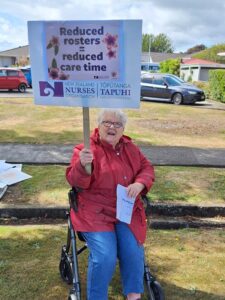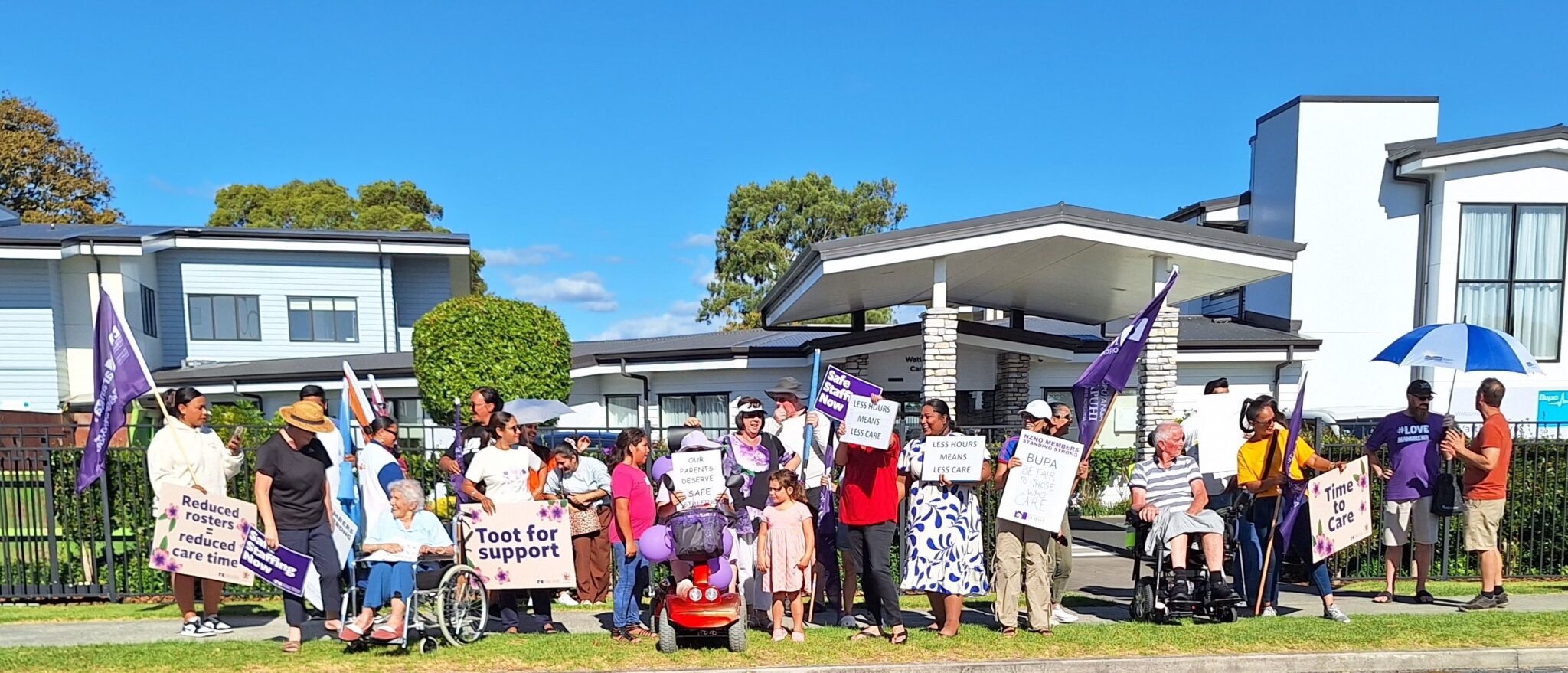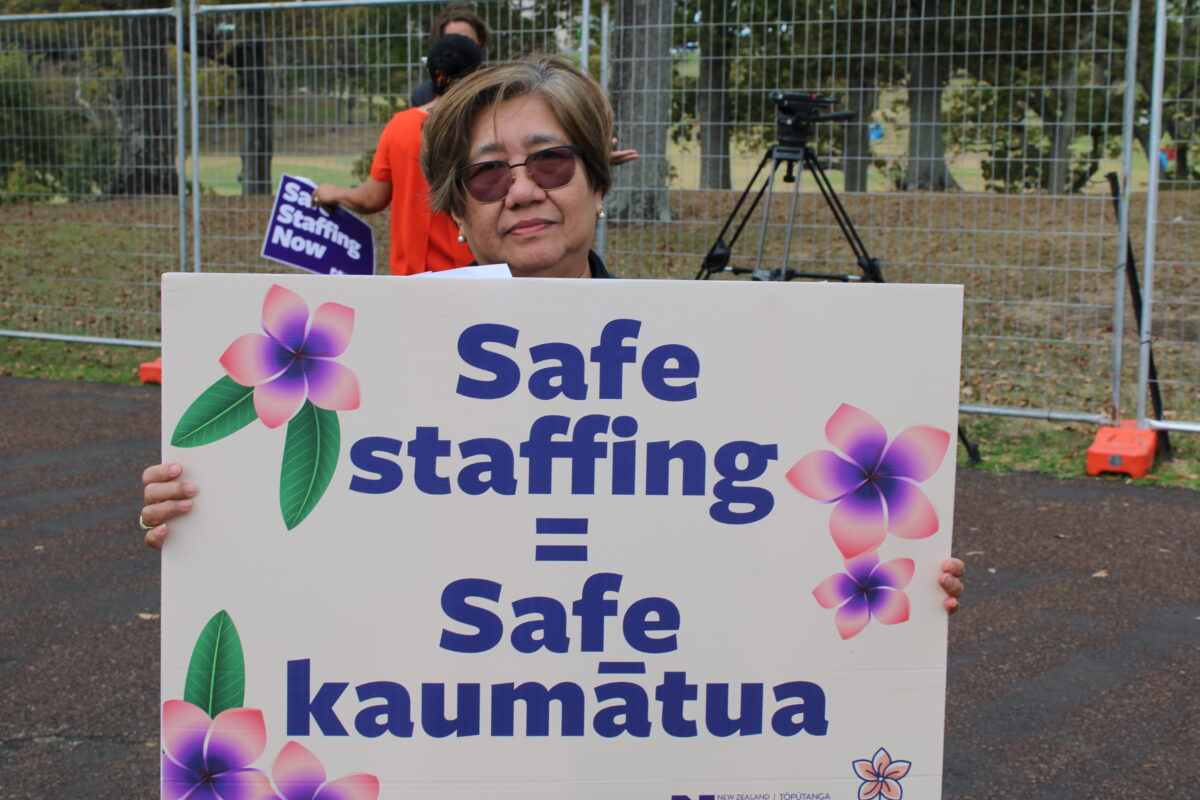‘Care in crisis’ recommendations for aged care:
- Registered nurse (RN) on site and on duty 24/7
- Assessing residents’ complexity now and projected, to plan funding into the future (“case mix”).
- Legally-enforceable, evidence-based and funded minimum safe staff-to-patient ratios, based on how many care minutes each resident needs per day to meet their clinical and cultural needs.
- Cultural safety embedded into clinical assessments.
- Aged-care workforce planning, with training and pay parity with Te Whatu Ora-Health New Zealand.
- Funding based on residents’ care minutes calculations.
- More aged care beds
- Mandatory reporting on aged-care safe staffing levels
- A workers’ voice committee in every aged-care facility including staff and union representatives, with access to rosters, staffing data and RN logs.
In new research released today by Tōpūtanga Tapuhi Kaitiaki o Aotearoa-NZNO, Care in crisis/Manaaki i te raru, aged-care nurses and kaiāwhina/health-care assistants (HCAs) reveal the reality of working in a critically under-funded sector.
The research is based on 80 in-depth interviews and 415 surveys of aged-care nurses and kaiāwhina/health-care assistants (HCAs) across the motu — nearly 500 aged care workers in total.
Nearly all — 96 per cent– believed their workplace was unsafe. More than half agreed understaffing was “systemic”, with shifts understaffed most of the time, or often. Even with a full roster, workers reported extreme pressure and not enough time.
More than 40 per cent said they couldn’t help kaumātua go to the toilet at least once per shift, having to leave them in soaking pads. Many nurses said they did not have time to care for wounds adequately, leaving residents at risk of infection. Constant pressure to rush and take short-cuts led to serious safety risks such as unsafe hoisting, lack of supervision and rushed care, the workers reported.
Read here to find what a 30-year kaiāwhina veteran learned about the elderly.
A quarter said residents were missing showers, getting meals late or cold and being left anxious, distressed and lonely most shifts.

Cultural safety, too, for Māori, Pasifika and diverse residents was “minimal and inconsistent”, the report found, along with a lack of beds particularly in rural areas, which tended to have higher Māori populations.
NZNO’s Age Safe campaign committee co-chair HCA Brianna Dynes said the report showed how much care residents were missing out on, due to lack of staffing.
‘I was surprised at the number of people who actually responded — we’re actually finding a voice for the staff out there.’
“Nurses and kaiāwhina are constantly forced to make impossible choices about who gets help first because they are stretched so thin,” she said. “Our kaumātua are being harmed by the sector designed to care for them.“
Age Safe co-chair Tracey Morgan said it was vital kaumātua Māori — along with all cultures — were cared for in a way that upheld their tikanga (culture) and whānau connections.

Key findings
- 96 per cent of aged-care workers surveyed believed their workplace was unsafe.
- 87 per cent said understaffing affected their ability to give good care.
- 54 per cent reported shifts were understaffed “most of the time or often”.
- 43 per cent did not have time to take residents to the toilet.
- 40 per cent of nurses did not have time to dress wounds.
- 40 per cent were thinking of leaving due to burnout, excessive workloads or moral injury and fear of providing unsafe care.
- 30 per cent of nurses did not have time to complete care plans for residents.
- Registered and enrolled nurses (RNs and ENs) were regularly replaced with health-care assistants (HCAs), often left unsupported, unsupervised and asked to work beyond their training.
NZNO college of gerontology nursing Bridget Richards — also on the Age Safe committee — said the report was “confronting, and very powerful”.
The aged-care sector had been fragmented and not well-unionised, said Richards, who has worked in aged care for decades.
“I was surprised at the number of people who actually responded — we’re actually finding a voice for the staff out there. We’re starting to gain traction in being able to support them, advocate for them and raise the concerns that they have.”
Residents tended to have multiple complex issues, including dementia, by the time they were admitted to aged residential care today, due to a preference to keep people at home, she said. That made it challenging, especially without enough staff.
The high level of knowledge and skills required to work with older people was not well-recognised.
“It’s about the one place in New Zealand where nurses can work to the top of their scope — and we need to make sure that’s recognised, and leading on into pay parity.”
Can we do better?

Cultural safety findings
- Aged-care systems are not Māori-centred
- Not enough Māori staff
- Widespread tokenism
- Anti-Māori behaviours
- Lack of knowledge of te Tiriti o Waitaingi
- Failure to follow cultural care plans
The report recommends blending Australia’s “care minutes” model — where aged-care providers must legally provide a minimum amount of direct care to residents each day — with Aotearoa’s new “case-mix” model — where funding is matched to residents’ complexity, for truly safe aged residential care here.
NZNO has long been calling for mandatory minimum staffing, transparent funding, culturally-safe care and worker voice, through its Age Safe campaign.
Seniors Minister Casey Costello said the report offered a “distorted” view of a sector that was not in crisis — and the Government had increased spending by $270m in the past two years. However, she said it had been “identified for some time” that the current aged-care model was out of date.
“This Government is looking at system-level change so that aged care is more effective and sustainable.”




